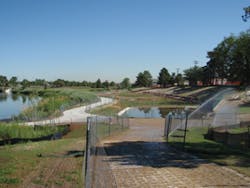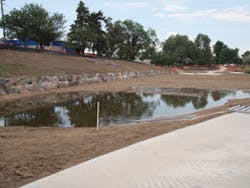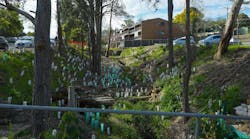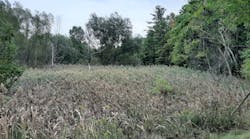“The city of New York has a world-class drinking water treatment system, and it keeps getting better,” says Bill Young of Young Environmental LLC. “What they’ve done is recognize how nature is the best for water purification, so New York City has gone upstate in New York and bought thousands of acres of reservoirs and buffer land, realizing that if they can keep the farms off and keep the roads off, and buffer them with forests and meadows, they’ll have clean water. And I think they have the cleanest water in the country.”
Young explains that instead of using chlorination, the city treats the water with ultraviolet radiation. A large UV plant is being built in Westchester County, NY, just north of the city, but wetlands were lost in the process. Three nearby wetlands were created to mitigate this loss, and that’s why Young was brought into the process.
“I’m what’s called a wetlands specialist or a restoration ecologist,” he says, “but I have a pretty cool niche. The Department of Environmental Protection [DEP] has learned a lot of lessons the hard way. Now they build into their specifications that the contractor must hire a specialist to help with this kind of work. Even though it’s designed at considerable cost, it doesn’t run on automatic pilot. There are a lot of on-the-job decisions that have to be made, including erosion control measures.”
Young wasn’t involved in selecting the sites for the new wetlands, but he explains how the wetland mitigation process works, in which new wetlands are built to replace wetlands lost to construction. The higher the quality of wetland lost, the greater the area of new wetland necessary to replace it.
“If you destroy a Lexus, you’ve got to put in 2:1 or 3:1, a higher ratio, because man doesn’t build things as good as nature does. If you destroy a Chevy, maybe it can be a 1:1 ratio, acre for acre. But it’s never less than 1:1.
“We have a “˜no net loss’ federal law, so every state has to at least comply with that. For this job, there are federal and state permits. Both agencies are looking for that no net loss. I think the ratio here is something like 2:1, which makes sense. We’re creating this wetland out of an upland, so we have to excavate to create wetland hydrology, wetland conditions.”
Young notes, however, that the preferred goal is no wetland destruction in the first place. “The rule, number one, is avoidance. They don’t just give you a permit when you say “˜I want to build something.’ But that has been satisfied legally-there’s no way to avoid this, it’s for the general good of society and so on. So they let us do the wetland.
“Next, you have to minimize your footprint-don’t build a big building if you can build a smaller one-so you have to prove that it is the proper size for the capacity you need.
“Then you have to do mitigation, or replacement. The rule is that the site should be within the watershed, and of the same type. You don’t want to lose a pond ecosystem and put in a forested wetland. You don’t want to lose a forested wetland and put in a wet meadow. You want to replace like with like.”
In the end, three wetland sites were built to replace what was lost in the footprint of the UV plant.
“One wetland site is called North Castle, which is in Armonk, NY. The second is Greenburgh, NY, very close to the UV plant. The third one is in Mount Pleasant, and you literally could throw a rock from the UV plant to the Mount Pleasant site. So two of the wetlands are local, on the Mine Brook, and one [North Castle] is about eight miles away. I can only surmise that this North Castle site was chosen to get the acreage they needed for mitigation; they weren’t able to satisfy that locally. This is in Westchester County, so there’s not a lot of land available.”
Wetland construction can be quite labor intensive, and proper planning is crucial.
“It’s a lot of excavation. It’s a lot of earth moving,” says Young. “The water table determines where a wetland is. So a stream is essentially where the water table reaches the surface. It’s where the water table that’s underground actually reaches the surface because it’s a valley, it’s low enough.
“The first thing we’ve got to do is to find a site and dig it out-so it involves a lot of backhoes and excavators. If you dig down 6, 7, 8 feet-it depends on where the water table is-you’ll find water. Now the designers come in and decide if they will make it a meadow system, or more of an open pond, or forested. And you want to replace the wetland that was lost, so a really good designer mimics.
“We do this with great humility. You mimic what is there. If it gets flooded every April and May, and that leads to a swampy condition, and then it dries out, that can still be a wetland. It doesn’t have to have constant standing water. You try to re-create that.
“It could be a wet meadow, which is herbaceous and open and sunny. Those are important, because there are a lot of animal species that require open, sunny meadows that are wetlands.
“In the case of the three wetlands on this project, we have a lot of shrub-forested wetland, with some open ponds and with some emergent wetlands. Emergent plants are native aquatic plants that emerge out of the water, so they stick up like a cattail or a reed grass.
“We have open water, we have emergent, then we have kind of a scrubby, shrubby wetland, and then it goes into forest. That provides a good gradient of wetland habitats.
“It’s literally driven by elevation. As the slope goes up from what they dug out, it’s like bands of plants. I helped do the layout. There are plants that are adapted to a band of hydrology of, say, 325 to 328 feet elevation, and there might be 30 species in that band. Then above 328 feet, there’s another whole set of species. There’s some overlap, but nature has great fidelity. A good designer puts plants that belong there, so without any assistance, these plants will grow and thrive and survive.”
After the wetlands were constructed, a five-year monitoring requirement kicked in. “That’s my preferred work,” says Young. “That’s my niche, wetland monitoring.” Results are reported to the regulatory agencies-in this case, the US Army Corps of Engineers and the New York State Department of Environmental Conservation, which issued the permit. “They surrendered a wetland that they’re charged with protecting for the citizens of New York,” he says.
“In a five-year monitoring, you have to prove to them that you’ve met the requirements. The requirements are things like 85% survival. If you have 80% coverage of native wetland species, you have not met the wetland conditions, and they’ll hold your permit. Normally, in the beginning, you might have 60%, because things are growing. For the first year, if we do 60 to 65%, it doesn’t mean the job’s a failure, it just means it’s on a trajectory, and it’s not there yet. Hopefully, you’ll get 85% in the second year, then up to 90 and 95%. Over the five-year monitoring period, the onus is on you to prove that it is indeed a wetland, and then they’ll sign off.
“After the five years of monitoring, our work is done. That means the regulators have signed off. They usually will go to at least one site visit, which is good to see. They’re protecting that for the citizens of the United States. They’re not doing any of us a favor-it’s the law. So they owe it to you and your children that this wetland that was destroyed in 2009 gets replaced. They’re usually pretty tough in that if it’s marginal, they’ll say that they’re not going to sign off. They’ll ask for another year of monitoring.
“But if you build it right, and you protect it from deer and major herbivores, you should be fine. You have to watch for invasive plants, especially in urban environments. They don’t want to see the invasives take over. So if you have a high percentage of invasive plants, that’s another reason they won’t sign off. But I’ve never been on a project that hasn’t ultimately been approved.”
As Young explains, however, surprises on the job are common.
“There’s never been a job that’s gone exactly as planned. All sorts of things come up, and that’s why somebody with a lot of experience is valuable to have onsite, because of unforeseen things.
“On the Greenburgh site, we had seeps. A seep is where the water is coming off a hillside into daylight. It actually comes out of the ground in mid-slope. It’s basically a spring, although a spring perhaps has a little more energy.”
The problem, he explains, is that a seep interferes with the bands of vegetation the designers have specified. “The seep totally negates that, because you have wetland conditions wetter than what was planned for. At Greenburgh, there are about seven of these seeps. If we planted what was called for there, they would have failed, due to it being too wet. Plants that were lower in the pond areas are totally adapted for full saturation, in standing water year-round. There are actually emergent plants that can live in standing water; they’re built that way. So that’s where they go.
“But halfway up the slope, we start to put in normal shrubs and trees-they’re still wetland trees, but they’re not adapted to constant inundation. What we had to do is modify the design to match actual conditions.
“Nature would put what belongs there. We took some plants that were designated for the wetter areas and put them in this area. Then we had to try to find a home for the drier plants that are now being displaced because of these seven seeps.
“So now we have to juggle the plants, which are already delivered, or on their way to being delivered. It may not exactly match the original design, but we get as creative as we can to find homes for everything. This way, the contractor is whole and gets paid for work that they did, the designer doesn’t look bad, and the city and the state and the federal government get the product that they planned for.
“You don’t fight Mother Nature, you embrace her. A seep is a natural phenomenon; there’s nothing wrong with it. By doing the excavation they did, it exposed the seep that might have stayed underground. Now all of a sudden, it’s exposed. A little bit of homework, looking at the subsurface hydrology, would have revealed that. They would have seen that where they’re excavating, there are going to be seeps exposed.”
Young adds that he uses erosion control devices extensively on his projects.
“We use biodegradable fabrics all the time. I think they’re the best thing that’s ever been invented. The best erosion control is vegetation. Where are there problems? Exposed bare earth. When you have a green cover, that’s all a surface needs. It’s bare soil that’s the problem. That’s why they have silt fences, why they have hay bales. They’re collecting runoff, turbidity, and suspended solids that are running off, clogging up our streams. It kills our aquatic habitat.
“We put down matting all the time. First, it’s mulch for the seed that’s under it, and second, it’s a protective cover.
“In this case, with the three jobs we’re talking about, they’re all on slopes. None of them is dead flat, so there’s always going to be runoff. Even though you put your seed mix down, it takes awhile to grow in. Vegetation starts out the weakest, and over time it curves up into where it’s the strongest. For the matting and the geotechnical components, we usually use coir, because it’s the longest-lasting natural fiber, and it will decompose. You don’t want to use plastic-the animals get stuck in it, and it doesn’t break down.
“But this matting starts out really strong, it assists the vegetation in growing, and it declines and gets weaker and breaks down over time, as it’s supposed to.”
Noting that coir is essentially a byproduct of the coconut industry, he says, “I love it that we’re taking a waste product and turning it into a really good useful product for society.”
He notes, “Erosion is something you want to prevent; you don’t want to react to it. You want to be proactive. If you have a good design and you have everything in place, erosion control becomes a non-issue, but that doesn’t mean it’s not critical. You just have to plan for it. For instance, at North Castle, we were not allowed to excavate over the whole site, which a lot of contractors do. We were only allowed to do it in phases, so you could start healing and finishing areas, while other areas were still under excavation.
“We started doing some of the middle-phase work right away, and then some areas were being finished while other areas were hardly started yet. I’m all for that phasing approach, and believe that good design carries the day.”
He says the three wetlands are all doing well, and new wildlife is coming in as the food web expands and new niche habitats are created.
Indoor Wetlands
Dave Whitney of EcoSolutions LLC in Vermont explains that wetlands actually encompass a greater variety of options than may be commonly understood.
“There are three criteria that are used to determine what a wetland is in nature,” he says. “There must be hydric soils-soils that can hold moisture-and the presence of plants, and at some point in time the soil has to be saturated for at least seven contiguous days.
“By that definition, that opens up bioretention systems, like rain gardens. These are technically wetlands. So a whole host of low-impact design stormwater treatment systems end up being wetlands.”
Another example of an out-of-the-ordinary wetland is the one Whitney created at Jasper Hill Farms in Greensboro, VT, a small rural town in the northeast part of the state.
“Jasper Hill is a farm and artisan cheese producer. It’s hilly and mountainous, so there’s not a lot of flat spots,” he explains.
The farm has fewer than 100 cows, but the state wanted the owners to put in a manure pit for the herd. The goal was to minimize the level of nutrients from the manure that enters the groundwater.
As Whitney notes, “Traditional methods would be to throw it all into a manure lagoon, and then you’d have to pump that manure lagoon and you’d spread it all over. It’s not a very efficient nutrient transfer process. A lot of it just runs right off.”
So Whitney offered an alternative approach.
“We decided to try to put the manure and the waste to work. We came up with this plan to take the manure and compost it, and separate the liquid out, and then mix that liquid with the whey from the cheese process. Then they run the liquid manure and the whey into an anaerobic digester to generate methane gas. That is then used to heat up their pasteurization water.
“The discharge from the anaerobic digester goes into our greenhouse-space constructed wetland to polish it before it goes out and is released back into the environment. So they take the heat from the compost process, where they take the solid manure, and they use that to keep the digester heated up to 95 degrees so it can generate methane. This also helps keep the greenhouse warm.
“What that does is take it from high-strength wastewater down to medium-strength wastewater. It comes out of there and gets broken down and should meet the same treatment standards as a wastewater treatment plant.”
Inside the greenhouse, Whitney created seven separate wetland chambers, each about 7 feet by 9 feet, and 6 feet deep. They are composed of cast-in-place concrete basins, lined with epoxy, and topped with compost and a variety of plants. Two of the cells have native wetland plantings; the rest have tropical wetland species that the farm plans to use to supply cut flowers. As Whitney explains, with a greenhouse temperature of about 90 degrees, most native Vermont plants wouldn’t be suitable for this environment.
“The whole purpose is that they wanted to reduce the nutrient discharge from the farm,” says Whitney, “and it’s working because it gets processed and consumed within the greenhouse. I should point out that they take the compost of the dry portion of the manure, and they spread that on the field, so they can use that for fertilizer. They graze cows there, and they don’t have a lot of pasture land.”
Whitney reports that other farms have begun expressing interest in similar wetland setups.
“It actually makes sense, especially for these small artisan cheese producers, where they spend a lot of money and energy heating up their pasteurization water. That water is typically about 160 degrees, and you use it twice a day, but you’ve got to store about 1,000 gallons of water that’s kept at 160 degrees. It’s pretty energy intensive.”
Whitney adds, “Working in the greenhouse, we didn’t have to worry about erosion control measures. Typically, when we do these wetlands outdoors, erosion control is a serious issue and we can’t do earthwork between October 15 and April 15. The weather is part of the problem, but specifically, the winter erosion control techniques we would have to do become cost-prohibitive. So by getting the shell up ahead of time, we were actually able to work in the greenhouse.”
Barnum Park Wetland
Denver’s Barnum Park is a 40-acre multipurpose area with steep slopes that offer stunning views of the downtown skyline. To handle stormwater coming off the adjacent Federal Boulevard, a busy Denver thoroughfare, the Colorado Department of Transportation opted to build a new constructed wetland, to store the stormwater runoff before it ultimately reaches the 4-acre Barnum Park Reservoir.
Joe Schneider of Western States Reclamation discusses the project. “Scott Contracting did the earthwork portion of the job, pushing back the embankment and putting in a large retaining wall. We constructed the wetland and did the site stabilization on the park side last spring, with erosion control blankets, seeding, and mulching, and we planted all the wetland plugs. It was a design-build irrigation system. That was completed last summer, and we’re now in a two-year maintenance phase with that.
“We put in jute blankets and fescue seeding, to help stabilize the slope-about a 3:1 slope-that leads down into the wetlands area above the retaining wall.”
The newly created Barnum Park Wetlands now catches stormwater runoff from Federal Boulevard. The stormwater system first directs the runoff into a concrete basin, from which it drains into the wetland, which is approximately an acre in size. Any overflow from the wetland enters the Barnum Park Reservoir, just west of the project.
Schneider says more than 10,000 wetland tublings were planted in the wetland, along with over 1,200 willow cuttings and a variety of native shrubs and trees.



